December 2006
![]()
Essays, poems, opinions and humor on seeking
and finding answers to your deepest life-questions
|
This month's contents:  Japanese bridge and waterfall
Japanese bridge and waterfall
The Early Teachings of Richard Rose by Mike Gegenheimer | The Dead by Billy Collins | Is What You See Real? by Art Ticknor | The Darkness of God (part 1) by John Wren-Lewis | Poems by Shawn Nevins | The Prayer of Looking by Bob Fergeson | Humor
|
The Early Teachings of Richard Rose
by Mike Gegenheimer
When you are drawn into a spiritual search, it can be an interest in a peripheral question which has first caught your eye; or a perception about life which gives you a seemingly special insight; or a trauma or death which turns the head and leads to sincere questioning.
Whatever the cause, the first steps, if pursued, will bring results. It is a like the line from the book 1984: "One plus one equals two, and all else follows."
Early meetings with Richard Rose often started with a rapport session to get peoples' heads in the room. Then conversation would begin, typically around a topic ... "What is your chief feature?" "How do you define love?" "What is thought?"
Questioning followed, sometimes called "confrontation." But, the person's answer was not as important as having them become aware of their thinking or unrecognized beliefs; or how their mind functioned—the purpose of confrontation is to know the mind.
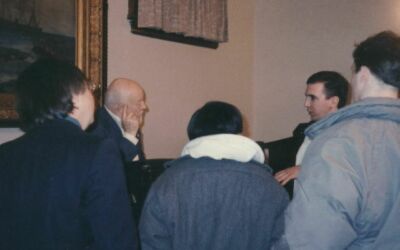 Richard Rose after a public talk
Richard Rose after a public talk
Rose was so skilled that often meetings were like living poetry. On the rare weeks he was absent in the early days of the group, we would try hard to hit the right balance, sometimes succeeding, sometimes being ineffective or, alternately, too harsh. But, we persisted. During each of the early meetings, Rose would review the Albigen System.
"First thing you have to do is get your head on straight," Rose would remark. "If you are drinking or doing dope—stop." "You have to get your house in order, physically and mentally, before you can begin."
Out would come the stories of the "man number one," physical animal man and the experience that might raise him to "man number two," the emotional man. Then he would describe the experience of man number two as he conquers his emotions to become intellectual "man number three." And then he would describe the eureka of man number three as he becomes the philosophical "man number four."
All of this engendered some questions, some discussion. And the principle of retreating from untruth was explained.
…And the conversation would continue. Rose would speak of the three-fold path, and begin the explanation found in The Albigen Papers about this path of action. "There are certain laws of human effort…" leading to the discussion of the law of the ladder, the contractor's law, the law of love, and so on, found in The Albigen Papers.
Then Rose would turn to the description of the "Maximum Reversal Technique": develop the intuition, build curiosity into desire, and "retraverse the projected ray." We all variously began taking action. The latter instruction concerning "retraversing the projected ray" was always puzzling. But, in retrospect, the various aspects of our effort lead us in that direction.
Then the sense of momentum began to be felt by many who sensed their heads were clearer, their energy higher. Things began to happen in the group.
The discussion of celibacy made sense; and the cumulative effect of various practices proved out Rose's guidelines as each in his own way made progress.
Private rapport sittings were instituted among the more serious members of the group, and Rose helped sort out the sub-groups of members according to his sense of their compatibility in rapport.
As people began to free themselves from various hang-ups and vices, some fell back into their traps; some left the group freer than before, but following some other wrinkle of obsession. But, those that remained, and there were a few more each year, became more sensitive and grew in understanding without, perhaps, realizing it.
People continued to benefit from the tension of confrontation sessions and from the "betweenness" of rapport sessions, which created the leaps and shocks that helped advance the understanding of their minds and awareness.
Some events were more remarkable than others were, but all served to demonstrate that group action could be of benefit to its members. The more remarkable events demonstrated direct mind contact, and not only the possibility, but the reality of transmission of mind. Other events demonstrated the existence of adverse forces.
As the group matured slightly, Rose handed over group meetings to monitors, and he began to speak more widely and began working on subsequent books.
These additional efforts expanded on some themes and captured new topics. But let's look again at the early teachings.
![]()
Unlike a college professor, Rose was a true teacher who lived the subject matter of which he spoke. He did not just learn it, practice it and speak authoritatively—he lived it and became the Truth.
He exemplified what he taught—he walked what he talked. Over the years the direction he pointed was consistent and the same—to look inside, to go within. We were like kids learning soccer skills, generally knowing why, but not seeing the whole field.
So let's talk through some of the basics. The three-fold path. In The Albigen Papers Rose speaks of the three-fold path—the Way, the Truth and the Life—and compares the Christian and Buddhist descriptions of the path. But, more than repeating these words, he inspired us to engage in activities, along the Way, towards the Truth (actually retreating from untruth), living the Life of brotherhood … Confrontation, meditation, spontaneous rapport sittings, and eventually planned rapport sessions … we began with his help to apply the best practices. In some ways, intuitively recognizing what we were doing, but "not seeing the whole field."
The Maximum Reversal Technique
This is described in the eighth chapter of The Albigen Papers and also in his book on Energy Transmutation, Between-ness and Transmission. It has three aspects:
- Developing curiosity into desire;
- Developing the intuition—the finite mind becomes less finite; and
- Consciously retraversing the projected ray.
Rose emphasized that, in practicing these, one cannot postulate the Truth beforehand. One can only retreat from untruth, and accept that which is.
Developing curiosity into desire. We began taking action. Based on our initial interests, we began working together, building vectors of action, which lead to more action. Meetings, posters, book stuffers, campus lectures, the Ashram, meditation, confrontation, rapport … we began living a life more consistent with that of a seeker. And when you commit yourself to know the Truth and act on that commitment, you begin to feel momentum. You retreat from the manifestly absurd attitudes, drop petty egos, review past traumas in meditation … you feel momentum and understand the meaning of a vector … away from untruth. Your curiosity builds into a desire to know more. And ultimately to become the Truth.
Developing the intuition. Rose often stated a quote from a religious philosopher, "The finite mind will never perceive the infinite," but he added, "The finite mind can become less finite.…"
In the group meetings—confrontation meetings—Rose seemed to know our thoughts and motivations before we did. He knew the reasoning (and rationalizations) he was hearing before we did. And when we began confronting each other, we developed rapport, personal insights into each other, into ourselves, and began to understand the reasoning in our thinking. But individuals all have different blocks and hang-ups. And this is where the specific teaching outside the general text occurred—from Richard Rose and from each other. And the purpose was not to drive ourselves to a belief … the purpose was to challenge our thinking; to know the mind. Richard reminded us when we became too heavy handed, "the purpose of confrontation is to know the mind."
And following Richard's advice, the practice of celibacy and avoidance of dissipation improved the intuition. When one closes the doors, others open. The impact manifested itself clearly, personally, and in group settings.
Consciously retraverse the project ray. This was a point that Richard spoke of less directly, indicating it was understood when looking back … and so it is. In Introduction to the Albigen System (an audio CD of a lecture), he hits on this point when describing one of the four attributes of a true Zen system—"direct pointing at the soul of man"—and notes that when looking inside, observation of one's thought occurs from a point along the ray.
In later years, Rose stated the basic elements needed for spiritual effort in others words, but always the three elements of the maximum reversal technique can be seen in them.
In one conversation, Richard noted that if there was no Albigen System, to find an answer all that was needed was to be celibate and engage in intense self-psychoanalysis until the mind stops. In Dave Gold's book, After the Absolute (p.89), he quotes Rose saying: "Three things are necessary: desire, energy and commitment."
In these early days of the group, Rose was there, actively engaged with us in practicing the Way of seeking; the Life of brotherhood; with the Truth as our objective.
The Self as an Obstacle
By now, this may seem to many to be obvious, but at the time, at the outset, this was not the problem many saw in front of themselves. But once you begin to seek, you recognize the fallibility of your perceptions, your mind, and your faulty sense of reasoning. The relative mind and its states of mind, egos and urges is the battlefield. Rose describes this poetically in the first of The Books of the Relative, found in Carillon (his book of poetry). It begins: "My name is legion, but I have but one Lord. I am an army standing against myself, and for the dust of my flourishes I cannot see my Lord." That writing goes on to describe the battle against the self—the retreat from untruth—you experience as you challenge your egos, observe and reject erroneous thinking and its causes. Until what remains? "I am the beginning and the end. I am the bowman, the arrow , and the victim. I am the way. I am the path. I am the Ladder…. I speak and thou hearest Me not. I am the Truth. I am the Love. And as I promised, I and thou are one…. I am the voice of silence. I am the joy and the sorrow. I am the beginning and the end. Be still and know I am the discernment."
When I first read this, I felt, "how anti-climactic to say, 'I am the discernment.'" But as you read the Psychology of the Observer (another of Rose's books), and engage in this work, this may become more meaningful to you.
But this is not a history lesson. The Albigen System provides means to accelerate efforts. Simply begin to act.
- Take your inspiration, your interest, and develop it into desire for Truth; develop it into a commitment to yourself.
- Seek to use your intuition, work with others. It does not require Rose; employ best practices with others.
- Retreat from less truthful activities in your life—question why you do the things you do and drop the ridiculous.
Tension will develop; so will a sense of momentum. You need to build the energy and momentum in a direction—retreat from untruth—with a "determination greater than death."
~ From a presentation given at the April 2006 TAT conference "What Is Spiritual Action?" See the April 2006 conference page for DVD information.
![]()
The Dead
by Billy Collins
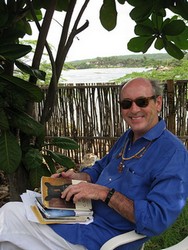 Billy Collins, by Suzannah Gilman, Jamaica 2010
Billy Collins, by Suzannah Gilman, Jamaica 2010
"The dead are always looking down on us, they say...."
![]() watch the animation on YouTube.
watch the animation on YouTube.
The print versions that were available on the Web seem to have disappeared. We contacted the University of Pittsburgh Press, which controls permission to display the poem, to ask if they would forego their fee for a non-profit use, but we didn't hear back from them. So we've provided the above link as an alternative.
~ Billy Collins is professor of English at Lehman College of the City University of New York and America's Poet Laureate for 2001.
![]()
Is What You See Real?
by Art Ticknor
In the January 2006 issue of the Dana Foundation's newsletter "Brain in the News," there was an article about Esref Armagan, a 52-year-old Turkish man who has been blind since birth. Armagan "has never seen a coffee cup, a toothbrush, an elephant, or a tree-lined street, but he can draw them each, from any perspective, with or without shadows depending on the time of day.... Though [he] has never had an art lesson, the streets he paints stretch into the distance as converging parallel lines." Harvard researchers, the article reported, found to their amazement when doing brain scans: "Esref's visual cortex lit up during the drawing tasks as if he were actually seeing."
You may think you see with your eyes. Buddha (c. 500 BC) knew differently: "The eyes seeing forms is equivalent to blindness; the ears hearing sounds is equivalent to deafness." Foyan, a Ch'an master who lived about 600 years after Buddha, told his students: "You are always in the light, and yet do not know it, even with your eyes open." Why? What were they talking about? The view, we could say, from inside the cosmic egg.
 Exterior of Guggenheim
Exterior of GuggenheimMuseum in NYC
What is spiritual action, and what's the relation of action to realization, to awakening? Beliefs are what keep us trapped, asleep and dreaming in the cosmic egg. The first step to realization—primary spiritual action—involves getting some perspective or detachment from those beliefs.
Frank Lloyd Wright was one of my heroes as a young man. One of the buildings he designed was the Guggenheim Museum in New York City. The main part of the museum is an open space, like a cylinder whose wall is canted outward as it goes up. There's an ascending ramp from the main floor that spirals up along the wall, with paintings hung on the wall, to your right as you ascend the ramp.
 Interior of Guggenheim
Interior of GuggenheimMuseum in NYC
Suppose you went to the Guggenheim as a child with your parents or on a school outing and, upon entry, a conveyor belt carried everyone shoulder-to-shoulder along that outer wall up the spiral—with your nose no more than an inch or two from the paintings. You wouldn't get much of a perspective, would you. Getting perspective requires that you stand back from what you're observing. Some ways to encourage this:
- Clear some space in your life:
» Do a media fast—eliminate Internet surfing, TV, video games, magazines, newspapers, books, movies, music, etc. other than that strictly required for school or work, for a defined period (one week, for example).
» Spend a scheduled period of time alone each day without the typical distractions. Use it for introspection—gain clarity as to your life-objective and roadblocks.
» Do a solitary retreat once or twice a year, where you devote a weekend, a week, a month to getting a break from the daily routine and finding renewed inspiration for what's supremely important. - Eliminate habits that cloud the mind.
- Introspect the mind—watch without judging. Implement self-inquiry: Why am I doing what I'm doing? What is my innermost desire? Who is living and facing death? etc.
- Clear up the subject-object confusion. "You are never that which is seen."
- Allow your mind to recognize/remember its connection to something bigger than itself—find the mental umbilical cord that connects you to your source.
Finding the umbilical cord and following it Home is on the "feeling side" of the mind. Music keys into the longing for many people, and a piece of music that is able to ring the longing bell for many people is the Largo from Dvorak's 9th (New World) Symphony. Neil Armstrong, the first man to step on the moon, was so moved by it that he took it along on that mission, Apollo 11.
At the 2006 TAT spring conference, one of the participants with a beautiful voice sang the following lyrics to the Largo melody:
|
I. |
II. |
III. |
|
IV. |
V. |
VI. |
Those words may express a message from your inner self.
![]()
THE DARKNESS OF GOD: A Personal Report on Consciousness
Transformation Through an Encounter with Death
by John Wren-Lewis
This article describes a radical and lasting change of consciousness that has overtaken the author as a result of nearly dying by poisoning in 1983. The initial experience lacked almost all the dramatic features that have attracted popular attention in the many accounts of "near-death experiences" appearing over the past decade such as "out-of-body" travel, passage through a tunnel, review of earlier life, or encounter with apparently supernatural entities. It was more in the nature of a dissolution into a Nirvanic or void-state of undifferentiated aliveness, but it produced a major and apparently permanent awareness-shift far beyond the emotional reorientations that are commonly reported to follow close encounters with death. The change seems to correspond closely with traditional religious descriptions of mystical "awakening" to experiential unity with the essence of all being, from which viewpoint the mystical perception of reality is seen as simple normal consciousness rather than an "altered state," while so-called ordinary consciousness is recognized to be a clouded condition wherein awareness has become bogged down in an illusion of separate selfhood confronting an alien environment. This change of viewpoint represents a complete antithesis to the author's prior religious background, which involved total skepticism of all mystical claims and of near-death experience reports.
The overall experience provides independent confirmation to the change of direction that was becoming apparent, unbeknownst to the author, in the main body of research on near-death experiences (NDEs) in the early 1980s. Interest was being focused on the changes of consciousness that undeniably sometimes occur in crisis-situations, as phenomena of great scientific and human interest in their own right, rather than on inevitably contentious arguments about whether or not NDEs provide glimpses of another world beyond the grave. By viewing NDE phenomena in this new perspective, the author is able to suggest a possible psychodynamic mechanism underlying the clouding of everyday consciousness and, on this basis, to propose guidelines for future research towards less drastic means of inducing "awakening."
I said to my soul, be still, and let the dark come upon you, which shall be the darkness of god. —T.S. Eliot
 Spreuer Bridge dance of death
Spreuer Bridge dance of death
"Deathbed visions" have occupied a prominent place in popular lore from time immemorial, but during the past decade, reports of strange and apparently religious experiences accompanying close encounters with death have for the first time become the subject of serious scientific study. In prescientific cultures, such reports tended to become so quickly incorporated into the prevailing dogmatic or mythological thought-patterns that the separation of experiential fact from wishful fancy or didactic elaboration was virtually impossible: Who can say, for instance, how much of the story of Nachekita's visit to the kingdom of death in the Katha Upanishad, or of Plato's story of Er, or of Dante's Divine Comedy, sprang from any kind of mystical experience, and how much from intellectual invention designed to make philosophical points? It seems to have been necessary for our culture to pass through a period of total skepticism before the subject could be studied in a fashion that established a solid factual basis for such stories; even though the majority of medical and scientific opinion probably remains skeptical about whether or not these "near-death experiences" have any religious or metaphysical significance, there is now no serious doubt that they occur (Lundahl, 1982). According to a recent poll reported by George Gallup, Jr., in the book Adventures in Immortality, probably many millions of people—5% of the adult population (if not more) in North America—have had such an experience (Gallup, 1982). The phenomenon has indeed achieved the ultimate dignity of being initialized to NDE, and there is a highly respectable International Association for Near-Death Studies (IANDS) based at the University of Connecticut, publishing a first-rate scientific journal, Anabiosis. (See References for particulars.)
Journalists have not been slow to make capital out of this development. This usually takes the form of sensational claims that, thanks to modern medical advances, more and more people are nowadays being snatched back from the very jaws of death and are giving reliable testimony of having glimpsed the hitherto undiscovered country; the idea has even been made the subject of a movie titled Beyond and Back. And sensationalism notwithstanding, this could be considered a legitimate, if over-dramatic, extrapolation from the way the subject was approached by the first major pioneer investigator, American psychologist Raymond Moody, in his now best-selling book Life After Life (Moody, 1975). This inevitably provoked skeptical counterattack along three main lines: (1) if resuscitation occurs, it is surely arguable that clinical death never really occurred whatever the dearth of vital signs; (2) the common features of the accounts, which for Moody and other early investigators seemed so impressive, actually pale into insignificance when set against the wide differences; and (c) similar "religious" experiences have been reported by people in other kinds of stressful conditions where there is no question of clinical death, for example, when life seems to be threatened by a fall over a high cliff, or by a vehicle bearing down at great speed, yet the accident is completely averted by landing on unexpectedly soft snow or by the vehicle swerving at the last second (Noyes & Kletti, 1976). Skeptics argue that such considerations make hallucination a much more likely explanation of NDEs than any kind of "glimpse Beyond"—and an especially strong reaction along these lines has come from the psychiatric community concerned with care for the dying and bereaved, who suspect that behind all the fuss about NDEs lies their old bête noir, the escapist impulse to deny the reality of death.
In the past few years, however, an important change of emphasis has taken place amongst near-death researchers that renders all such skeptical considerations largely irrelevant. The specific content of NDEs, while undeniably interesting, tends now to be seen as secondary; primary significance is given to the unquestionable fact that a close encounter with death, whether clinically or only in a life-threatening situation, seems to produce in many cases a remarkable change of consciousness, which is worthy of study in its own right, and which, on any reasonable reckoning, is highly significant for our estimates about what kind of creature the human being is. In fact, psychologist Kenneth Ring, founder of IANDS and author of the first major scientific study of NDEs (1980), concludes in his new book Heading towards Omega (1984) that NDE studies are now emerging as a new and important subsection of the more general study of mystical and religious consciousness in the tradition of investigators such as William James (1958), R. M. Bucke (1923), and Sir Alister Hardy (1981). One might add that this makes the subject very much the business of humanistic psychology and, on that premise, I submit here an account of my own NDE in 1983, which pointed very clearly in the direction of Ring's conclusion long before his book came out and before I had read any of the NDE literature seriously. (A cursory glance at Moody's book had left me with very much the skeptical view outlined above.)
My NDE was much less dramatic in content than many that have hit headlines. I had no "out-of-body" vision of myself supposedly dead in the hospital, nor any clairvoyant perception of the medical staff discussing whether their emergency treatment had come too late to save me. I was given no overview of my life and no experience of hurtling through a dark tunnel to a heavenly realm beyond. I saw no unearthly landscape, celestial light, or marvelous colors, heard no angelic music, and met no deceased relatives or supernatural figures telling me to go back to my body because my work on earth wasn't done yet. On the other hand the aftereffects of the experience were dramatic indeed, and I have yet to read of anything quite like them in the NDE literature. The experience has remained with me ever since, not just as a changed attitude to life, however radical, but as a totally altered state of consciousness that has what I can only call eternal quality right here and now, so that I no longer worry about what happens after death.
To start, however, with the material facts—I had just emerged unscathed from a year in the Malaysian jungle with my wife, dream psychologist Ann Faraday, seeking to establish the truth or otherwise of reports about a special dream-culture amongst the Senoi tribe quoted in her books (Faraday, 1973, 1976; for our findings, see Faraday & Wren-Lewis, 1984). After a rest on the beaches of Ko Samui off the east coast of Thailand, we embarked on a long-distance bus to Phukett on the west coast. We knew nothing then of reports in the international press about thieves plying travelers with drugged sweets or drinks before making off with their wallets and luggage while they dozed, or of the sensational case where one pathological killer poisoned a whole coachload of people (Neville & Clarke, 1979). We heard one or two rumors, but having experienced nothing but generosity from everyone we'd met so far, we discounted these as scaremongering tales spread by hippies who'd eaten too many of the magic mushrooms that are on sale everywhere in Thai resorts. We had no suspicion whatever of the nice, well-dressed young man who helped us with our luggage and then, on this crowded vehicle in broad daylight, offered us Cadbury's toffees. They tasted distinctly musty, but I sucked on to the (literally) bitter end out of politeness; Ann, less inhibited, spat hers out; thanks to this I am now alive to tell the tale, for that particular thief evidently went in for injecting his toffees with overdoses and, had we both dozed off, we would have slept our way into eternity.
When the young man saw Ann wasn't eating her sweet, he realized his plans were foiled and left the bus hastily at the next stop (the last before we set off across country), just as I was beginning to feel drowsy. When my head dropped on my chest and I began to drool, Ann grasped what had happened but felt there was nothing to do now but let me sleep it off, so she stretched me out on the seat with a sleeping bag under my head. After a while, however, as the bus plunged on into the countryside, she noticed with alarm that I was going blue around the lips and had no detectable pulse. With difficulty, she persuaded the driver to stop (he thought I was drunk) and, after some hassle, managed to get me back to Surat Thani hospital by hitching a ride in a van. The doctors were not at a hopeful of saving me but made the optimistic assumption that my total lack of response to deep pain was due to the drug (they suspected morphine, which is very cheap in Thailand) rather than to imminent death, and they plied me with oxygen and antidotes by intravenous drip. It was about 7 hours before I showed any evidence of coming around, and they decided to put us up for the night in a private room.
It was some hours later still before I really surfaced to find someone asking if I wanted supper. For some time after that, I was so occupied getting in touch with what had been going on, I just didn't think about anything else; it was only after everyone else was asleep that I began to wonder why that rather shoddy hospital room seemed transcendentally beautiful. My first thought was, "Hey, is this why people get hooked on morphine?" But second thoughts told me that after all this time any drug effects should have worn off (a conclusion since confirmed by pharmacological experts). What is more, I had taken part in extensive research on psychedelic drugs in England in the late 1960s (Wren-Lewis, 1971) and had some extraordinary experiences, including an apparently transcendental experience of blissful white light under LSD, but my experience in the Surat Thani hospital room was nothing like that. It was altogether calmer, without any perceptual distortion, yet at the same time far more impressive. I began to wonder if I'd had some kind of "Moody" experience while "out," so I tried a technique that Ann and I have sometimes found useful when we wake up knowing we have just had a vivid dream but cannot get back any details.
I lay on the bed, relaxed, and began to take myself back in imagination, in a series of steps, right to the point of coming round. "Here I am, lying on this bed, with someone asking if I want supper; here I am, just before that, becoming aware of someone shaking my arm; here I am, before that again, with my eyes closed, and...." Often this process brings back the dream one has forgotten, but what came back this time was nothing like a remembered dream. What came back flooding back was an experience that in some extraordinary way had been with me ever since I came around without my realizing it. It was as if I'd come out of the deepest darkness I had ever known, which was somehow still there right behind my eyes.
One of the NDEs reported to Kenneth Ring (1980) was from a woman who said she had been enveloped in "a very peaceful blackness ... a soft, velvet blackness," and I know just what she meant—but I feel the need to say something stronger to do justice to my experience. A phrase that has since come to mind occurs in an ancient alchemical text; we now know that alchemy was concerned more with psychological and spiritual changes than chemical ones, and in one old book it is said that there occurs a point in the transformation where the operator "falls into the black sun" and experiences "a palpable absence of light" (an interesting psychological anticipation of "black holes"?). The darkness I experienced was in some extraordinary way radiant, and I cannot help thinking of the poem Night by Henry Vaughan, with its strange line: "There is in God, some say, a deep but dazzling darkness."
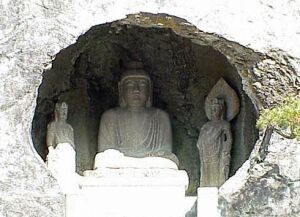 Vairocana Buddha of Samjon Grotto Temple
Vairocana Buddha of Samjon Grotto Temple
I am not trying to push any particular theological or metaphysical conclusions when I use the word "God" here. On the contrary, my readings in theology and metaphysics in earlier years never conjured up to my mind anything remotely like this experience. I am simply saying that since the experience, Vaughan's line and a whole host of other statements made by mystics in all religious traditions seem to make sense as word-straining attempts to describe the strange state in which I found myself; for instance: the Hebrew poet's cry in Psalm 139 that "the night shineth as the day," or Mohammed's statement that he experienced "the Night of Power," or the assertion of St. John of the Cross that he encountered God as "a dark cloud illumining the night." I am even led to wonder if similar experiences, rather than mere cosmological speculation, underlie references to "cosmic darkness" in some of the world's primordial creation-stories such as the "darkness on the face of the deep" in Genesis or the "darkness at first by darkness hidden" in the Rig Veda, or Te Po, the "first night" of the Maori creation story. I wonder if the Hebrew story came straight out of the experience of Abraham when he "fell into a deep sleep" at sunset and "lo, a dread and great darkness fell upon him" (Genesis 15:12).
Most stories about-near-death experiences mention darkness only as a prelude to some greater experience of light, usually the famous dark tunnel. Now of course, I can't say categorically that I didn't experience going through a tunnel—I simply don't remember any transition into the darkness—the only thing I recall before that was feeling drowsy on the bus. But I can say that it would seem utterly silly to think of the darkness, as I experienced it, as an intermediate state to anything else at all, for it seemed utterly complete. One of the rare exceptions to the rule in the near-death stories occurs in Raymond Moody's Life after Life, where a man reports a darkness "so deep and impenetrable that I could see absolutely nothing, but this was the most wonderful, worry-free experience you can imagine." I, too, felt utterly secure in my darkness, knowing that all life's struggles were over and I had "come home" to a state beyond all danger, where I no longer needed or wanted anything because everything I could possibly want or need was already mine. That shining darkness seemed to contain everything that ever was or could be, all space and all time, and yet it contained nothing at all, for the very word "thing" implies separate entities, whereas what I experienced was an utterly simple being-ness without any kind of separation—the very essence, it seemed, of aliveness, prior to any individual living beings. Another paradoxical expression, this time from Eastern mysticism, seems the only one that is remotely adequate—"the living Void," an idea echoed in Christian mysticism by Meister Eckhart's description of the Godhead as "empty, as though it were not," or in Jacob Boehme's reference to the deity as "a suprasensual abyss" (Eckhart, 1981; Boehme, 1970).
Another man reported to Raymond Moody that he found himself "just floating and tumbling through space," and then added, "I was so taken up with this void that I just didn't think of anything else." The idea that a void could possibly be interesting would have seemed nonsense to me before, but it now makes total sense. In fact, the state I am trying to describe seems to defy all ordinary canons of logic, and my deepest resonance is to Buddha's classic description of Nirvana, which simply piles one contradiction upon another:
Monks, there exists that condition wherein is neither earth nor water nor fire nor air; wherein is neither the sphere of infinite space nor of infinite consciousness nor of nothingness nor of neither-consciousness-nor-unconsciousness; where there is neither this world nor a world beyond nor both together nor moon-and-sun. Thence, monks, I declare there is no coming to birth; thither is no going; therein is no duration; thence is no falling; there is no arising. It is not something fixed, it moves not on. That indeed is the end of ill. (Pali Canon, 1968)
And even "the end of ill" has to be contradicted too if I am to do justice to my experience, for it was in no way merely negative. It was indeed "a worry-free experience," "a very peaceful blackness," but there was nothing at all lifeless about it; it was "the peace of God that passeth understanding." Words like bliss or joy are equally inadequate, for they are far too limited, which I think must be why the Katha Upanishad says that when its young hero Nachekita went to the kingdom of death he discovered a new kind of Self, the Universal Self, Brahman, who is "effulgent Being, joy beyond joy" (Hume, 1974).
Here again I must emphasize that I am not trying to push any metaphysical idea about a place or realm in which the soul survives after death. In purely medical terms I certainly came very close indeed to dying, but from what the doctors told me, I have no reason to suppose that I actually crossed the border of "clinical death," as is alleged in some NDE reports. And, subjectively, my experience was not of leaving the body, or of going into an apparently heavenly realm: It was not of going anywhere, but more like everywhere having somehow become present to me, or, more precisely, of somehow becoming present to consciousness without there being any more "me" to be conscious. And that is why I can so immediately identify with young Nachekita in the Upanishad: In that nirvanic condition there was aliveness or awareness, and, therefore, in terms of human logic, I have to say that there must have been some kind of Self, but the self of John with his personal history had ceased to be, finished. And I don't mean that my former life was forgotten—rather, I had the sense that all personal histories, mine and my friends' and those of all who have ever lived or will ever live, were now recognized as mere incidents in an infinite Aliveness that is beyond all history, beyond all space-time limitation. I feel—and feeling is what this is all about—that had I chosen to do so I could have reviewed my whole life, as many people have done in near-death experiences, or conversed with my long-dead relatives, or said hello to "angels, archangels and the whole company of heaven," but in that shining dark there was no desire for such separate experiences, since All was already present.
Skeptical psychologists and psychoanalysts often try to explain away near-death experiences by the theory that the mind conjures up fantasies of heaven in a desperate attempt to avoid the imminent prospect of its own extinction. I used to believe something like that myself, for although I was not an atheist, my Christian beliefs were of a very liberal-humanist-modernist kind, and I dismissed all mysticism as neurotic escape from life (Wren-Lewis, 1966). My experience completely shattered this whole line of thought, for it was utterly unlike any fantasies I have ever had of heaven, either in childhood (when my religious ideas were of the crudest possible Jesus-in-white-robes type derived from Sunday-school pictures) or in adult life, when I was repelled by the whole idea of Nirvana as I then understood it. But more important even than that is the fact that what I experienced was, quite precisely, the extinction of individual selfhood that the mind is supposed to find too terrifying to face. I think I have been privileged to have the experience promised by the Tibetan Book of the Dead (Evans-Wentz, 1957)—that the approach to physical death provides an opportunity for the ordinary limited self to "die," to give up grasping its little separated identity, whereupon the discovery takes place that selves are not separate, but simply manifestations of the only real Selfhood, infinite Aliveness. My guess now would be that all religious "fantasies," as the skeptics call them with some justification, and even those palpable visions of heaven that psychologists have to explain as hallucinations, are the mind's attempts to put pictures to its intuitions or occasional glimpses of this universal Aliveness underlying all individual existence, which in itself is beyond all picturing and all theological theories.
What makes me so convinced of this is that the nirvanic bliss was not just something I glimpsed once, while I was (from the doctors' points of view) unconscious: I brought it back with me when (from the doctors' viewpoints) I "came round," and I have had it with me ever since. Words and logic come under greater strain than ever when I try to describe the process of "coming back"; indeed that very expression is misleading from any other viewpoint than the purely clinical one, for as I said at the beginning, when I "clicked back" to the darkness by using the dream recall exercise, I found it was still right there with me at the back of my consciousness, as it were, and had been all along without my focusing the fact. And subjectively, I am up against something that makes no sense in terms of ordinary logic when I say that I came or moved out of a state where there is no time, for how can there be movement without time? In fact, I again find myself faced with a logical difficulty that occurs in the doctrines of all religious, the problem of trying to say how anything but God can ever exist if God is everything, as "God" must be by definition, and how time can ever get started when the very notion of "start" implies time. I used to think these were abstract metaphysical problems and probably meaningless word-juggling; now I feel sure those doctrines were originally attempts to express just the kind of impossible transition I went through from Nirvana to the rebirth of John.
So I can only say that it seemed as if the impossible happened, and a movement took place in eternity, which is beyond all movement. In the Jewish Kabbalah, (Schaya, 1973) it is said that the en sof, the Limitless, created (or creates, for this is beyond time) a space within itself so that limited being can also exist. In the Taittiriya Upanishad (Hume, 1974) it is said that Brahman changed from the pure Unmanifest to the Manifest (though of course there is nothing Other than Brahman for Brahman to manifest to!) To coin my own phrase, it was as if the personal me "budded out" from that eternity of shining dark, without ceasing to be the shining dark—which I suppose is what Hindu theology is trying to express by its famous statement that the Atman, the individual self, is identical with Brahman, the universal self.
![]()
~ From The Archives of Scientists' Transcendent Experiences (TASTE), edited by Dr. Charles T. Tart, Submission No. 00051, Submitter No. 00048, Posted: June 14, 2000. To be continued in the January 2007 TAT Forum, along with the TASTE editor's introduction and Wren-Lewis's reference material....
![]()
Poems by Shawn Nevins

|
"Pittsfield" Why would the name of a long-vanished town * How can each moment Best to stop there, * I would not wait another day, * A barred owl is deep in the woods. There is language and there is hearing. * An interior pilgrimage: * "Jars of Glass" Where is cold light reflected by glass? There are edges of clarity |
![]()
The Prayer of Looking
by Bob Fergeson
This commentary was written originally as a letter in response to the following question: "So, can the collective of impulse and energy called ego be 'tenderized' somewhat so as to allow it to get out of the way long enough for unending abiding in It? Or should I just get on with trying to learn how to get on the hamster wheel, serve others, and hope that the house suddenly and abruptly collapses on itself?"
Your question implies an either/or dichotomy, with the choice being one or the other of two states of mind. The answer is simpler: just look. To use the attention to observe. To find out for yourself, by observing yourself; an attentive listening. The end is found in self-inquiry, a questioning, rather than deduction. This questioning is not conceptual or thought based, but is a function of the attention. It is a feeling, found through intuition. You look without ideas, a functional "doing" of your listening attention. Whenever you question in this manner, you will notice there is no longer a problem.
This looking can happen very quickly and easily, but is soon lost. As soon as the experience is logged in memory and added to the ego's inventory, the mind will jump back in, steal the attention once again and declare, "Oh yea, I know all about this, now I've got the answer." As soon as the mind revels in patting itself on the back with what a good job it's done, we're back in the same old problem, the old dissonance and angst; the duality of the conceptual mind. So the answer is, again, to go back to true self-inquiry, to question, to look. To point the attention and look, while simultaneously lining the attention up with our source. Once you've felt this and know how it works, the answer lies in practice. Whenever the mind comes up and bothers you, and you begin to slip back into identification, question, look, and listen. If you keep this up, once you've found the trick of it and place value on it, value above the conceptual problem/solution trap of the mind, you'll again see what you really are, in the moment, rather than as a function of memory and ego. This questioning attention, when practiced and eventually turned within, will take you home. Everything will line up; there is no longer a problem. You are connected with your source, and there are no more questions as far as identity is concerned.
 When the mind jumps in and steals the reins after the experience of seeing, what you have is a separation from yourself.
You're lost in the mind again, looking outward for answers and identity in your experiences. This is what is talked about when it is
said that the experiencer is the product or creation of experience. It is of itself not real. It is a reaction to a reaction pattern. When
we have begun to see and admit this, we simply refer back, again and again, to questioning, a listening attention.
When the mind jumps in and steals the reins after the experience of seeing, what you have is a separation from yourself.
You're lost in the mind again, looking outward for answers and identity in your experiences. This is what is talked about when it is
said that the experiencer is the product or creation of experience. It is of itself not real. It is a reaction to a reaction pattern. When
we have begun to see and admit this, we simply refer back, again and again, to questioning, a listening attention.
This could be called a form of prayer. We pray to, and have faith in, our intuition. We're turning our attention back within to something we may have faith in but we can't really see. This nameless something or nothing, sometimes called the dazzling dark, a primal ground we sense behind or within us, has no image or form. When we are connected to this formless Is-ness, and then again turn our attention outwards, we are lined up.
"Life is real only then, when 'I Am.' " —Gurdjieff
When this attention is as a double arrow, one pointed within, one without, we are connected with our source and bypass the personality or response pattern, the experiencer. We now witness experience directly. This form of prayer needs to be practiced in every moment, as often as we can remember.
So keep questioning, keep this prayer of attention going. Practice it whenever and wherever you can, as often as possible. You'll find it does not interfere with action or your day-to-day life, but it will interfere with the mind, its fantasies and endless problems.
~ See Bob's web sites, The Mystic Missal, NostalgiaWest, and The Listening Attention.
![]()
Humor from Winston Churchill...
"If this is a blessing, it is certainly very well disguised." "When I look back on all these worries, I remember the story of the old man who said on his deathbed that he had had a lot of trouble in his life, most of which had never happened." "I like pigs. Dogs look up to us. Cats look down on us. Pigs treat us as equals." Lady Nancy Astor: "Winston, if you were my husband, I'd poison your tea." |
Reader Commentary:
(We appreciate hearing from you.)
|
Sign up for our e-mail alert that will let you know when new issues are published. Contact the Forum for questions, comments or submissions. Want to help? Your donation of $5 or more will support the continuation of the Forum and other services that the TAT Foundation provides. TAT is a 501(c)(3) not-for-profit educational organization and qualifies to receive tax-deductible contributions. Or, download this .pdf TAT Forum flyer and post it at coffee shops, bookstores, and other meeting places in your town, to let others know about the Forum. |

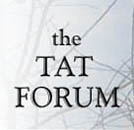
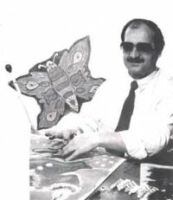
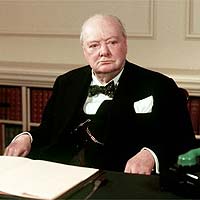 "He has all the virtues I dislike and none of the vices I admire."
"He has all the virtues I dislike and none of the vices I admire."